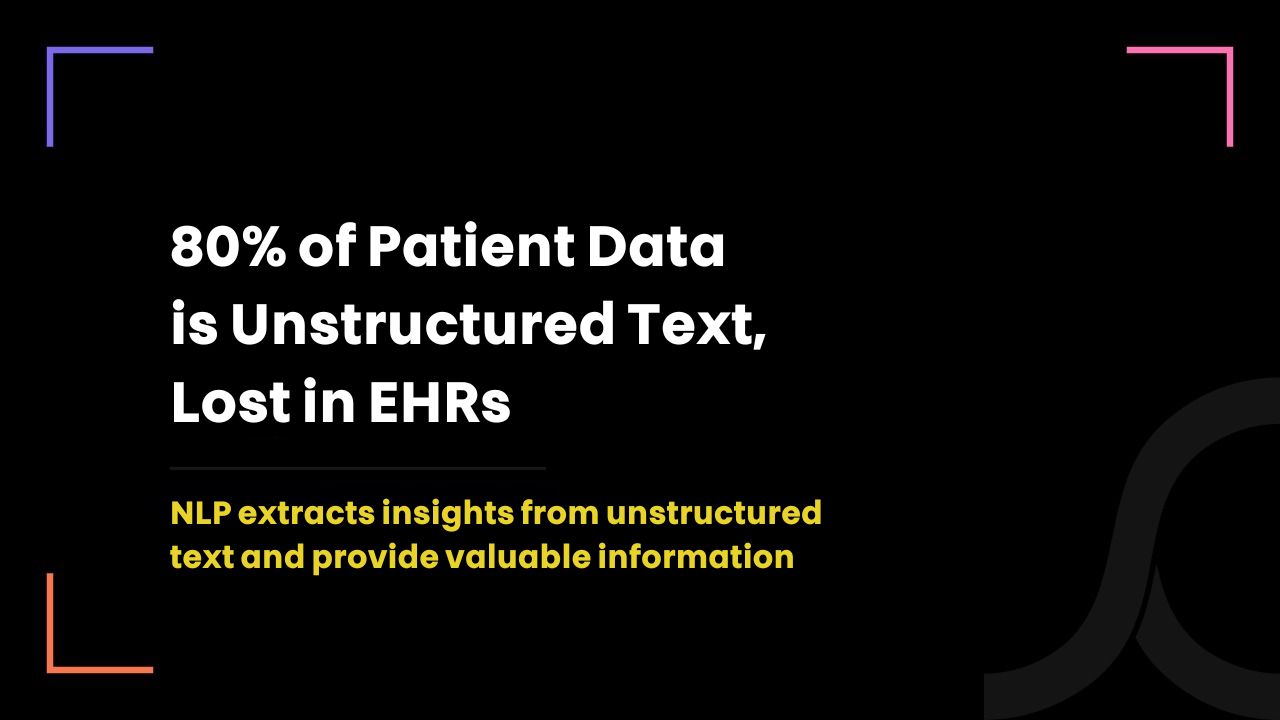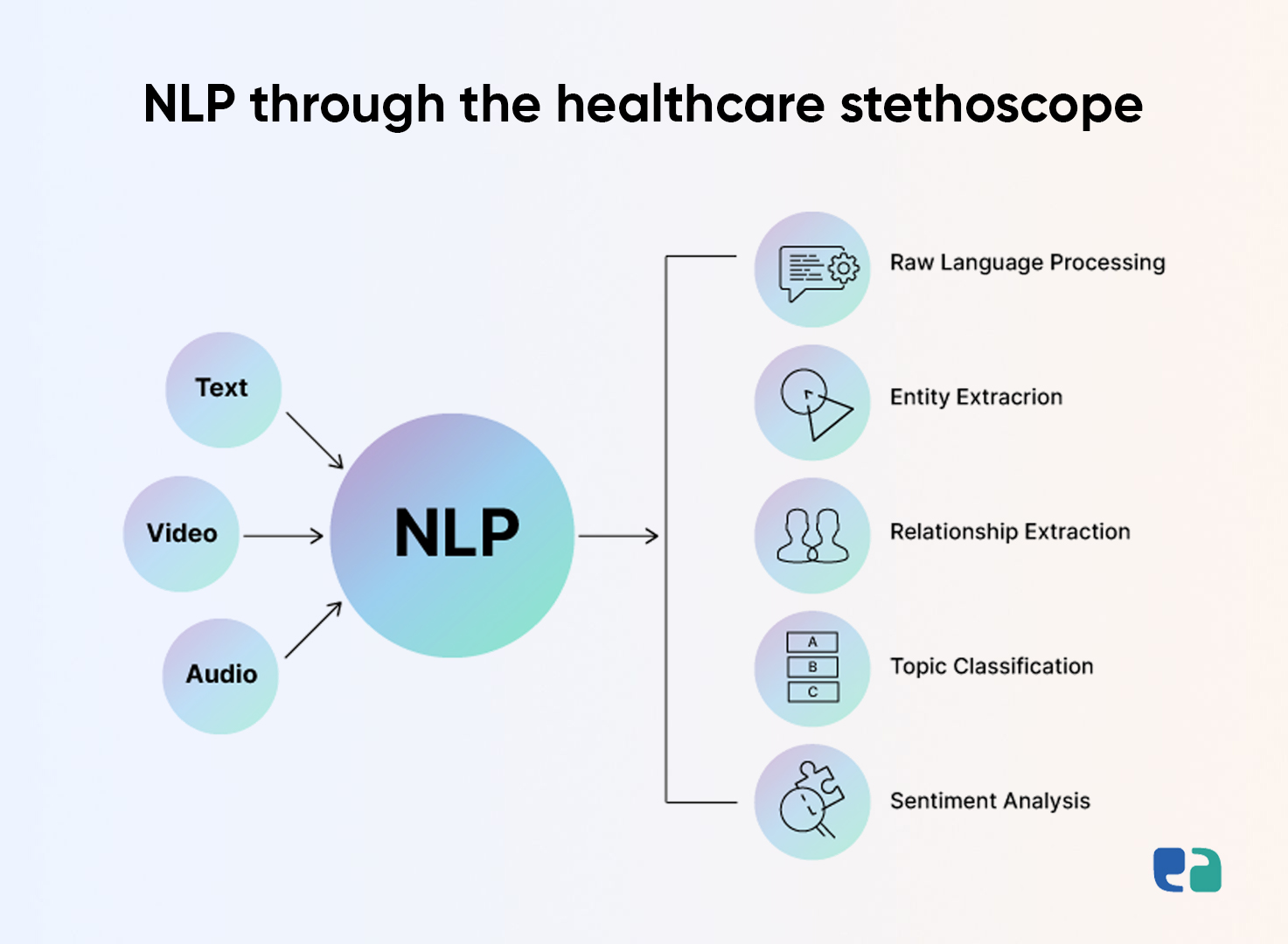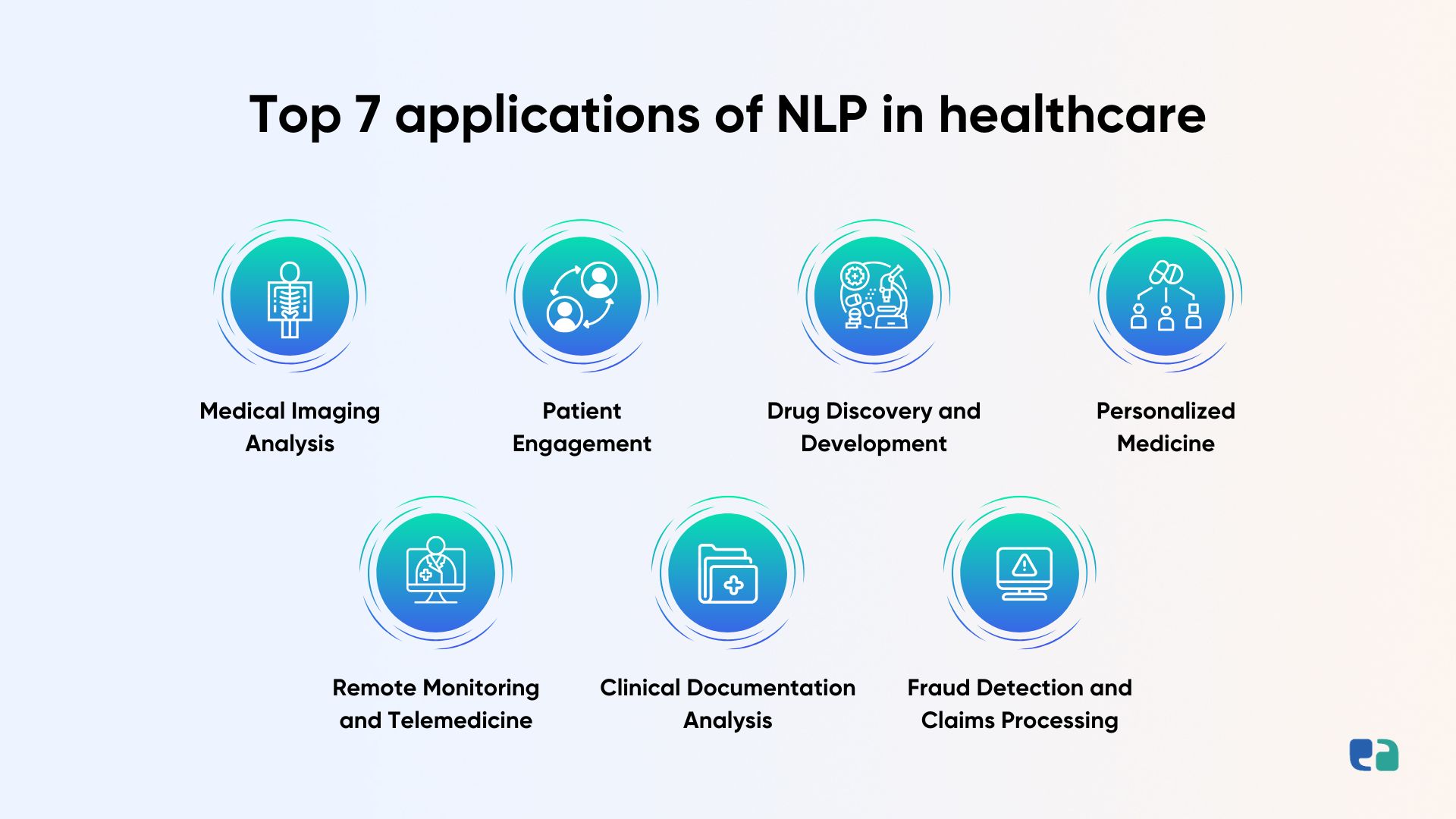How to Implement NLP in Healthcare: Benefits and Applications

11 months ago
There is too much burden on the shoulders of Canadian healthcare.
Reason – staff shortage and high patient flow.
In this chaos, they forget one thing, optimal storage and use of patient data.
There is tons of data stored in hospitals regarding patient treatment and administrative work.
You will be surprised to know that 80% of this medical data is unstructured text, which is somewhere lost in the EHR system.
The data can give some amazing insights if it is utilized well. But that's not humanly possible.
This is where Natural Language Processing (NLP) steps in.
Another branch of today's star technology, artificial intelligence.
Its computational power pulls insights from unstructured text and gives valuable information.
You can also utilize the power of NLP in your hospital or any kind of healthcare practice. Let's see how.
Let’s Understand the Difference Between NLP, NLU, and NLG in Healthcare
1. Natural Language Processing (NLP)
Computers don't understand human language like we do.
There is a different way to teach language to this machine.
It is made possible by combining computer science, artificial intelligence, and linguistics. This combination is known as NLP.
In healthcare, NLP can be used to process various types of unstructured data, like:
- Doctor’s notes
- Medical records
- Research articles
- Patient conversations
NLP uses various techniques to analyze text and pull out important information.
A common technique in healthcare NLP is named entity recognition. This technique identifies key terms like names, places, dates, and medical conditions.
This helps computers to organize and analyze clinical data.
2. Natural Language Understanding (NLU)
NLU is the extended process of natural language processing.
It helps computers to understand the deeper meaning behind text.
- Apart from reading the words, NLU analyzes the syntax (grammar) and semantics (meaning) of sentences.
- Recognizes context in medical phrases (e.g., understanding that “relative at bedside” means a patient has support, even if the word “support” isn’t mentioned)
- Uses ontologies, which define relationships between words and concepts, for better comprehension of healthcare-specific language
NLU provides context to the data so that computers can interpret clinical text like doctors do.
3. Natural Language Generation (NLG)
It is also a part of NLP. It helps the computer to generate human-like text from the data. It is commonly used in:
- Generating summaries of complex data
- Creating patient reports or explanations in easy-to-understand language
- Text-to-speech applications
NLG allows healthcare data to be turned into clear and human-like text.


Healthcare NLP: Benefits, Applications, and Real-World Use Cases
1. Benefits of NLP in Healthcare
A. Giving Key Information from Unstructured Data
Most of the data is unstructured, but it has some hidden value inside that humans can't read. But NLP can give useful insights.
For example, NLP can identify the patients who are at high risk of readmission by analyzing his discharge notes.
B. Improving Efficiency and Accuracy
NLP can automate multiple tasks, including medical coding and billing. A good tool that saves staff time, cost, and also reduces clinical errors.
C. Enhancing Patient Care
NLP can analyze the patient history and also look into the current condition. Its computational power gives critical information that can help doctors provide better care.
It's the best tool to create a personalized treatment for the patient.
Chatbots, another application of NLP give easy information access to patients in a few clicks.
2. Applications of NLP in Healthcare

A. Streamlining Clinical Documentation
Managing clinical documents is a tedious job, but NLP can do it in a fraction of the time.
There is one NLP solution named Dragon Medical One, which allows doctors to dictate their notes. These notes are then automatically transcribed.
- Save time
- Improve accuracy
- Reduce errors
B. Supporting Clinical Decision-Making
Have you heard about a popular NLP tool from IBM Watson for Oncology?
It's a great tool that analyzes data from patient records and suggests evidence-based treatment options.
With the help of this tool, doctors can make informed decisions.
C. Predictive Analytics
If you can predict the disease earlier, you can treat it better. And it's now possible because of NLP.
It can analyze the patient data and flag those who are at risk of readmission or developing chronic conditions like diabetes.
Early intervention can help these patients.
3. Use Cases of NLP in Healthcare
A. Extracting Insights from EHRs
NLP is like a detective for all the messy and unstructured data in Electronic Health Records (EHRs).
It digs through heart failure stats, COVID-19 risks, and even severe pregnancy complications.
A great tool for finding clues that might have been hidden.
B. Patient Interaction and Support
How you ever talked to a chatbot about your symptoms? Well, with NLP it is possible.
Mount Sinai uses it to power symptom checkers that give patients instant information about their health queries.
No waiting for a doctor's appointment — get quick answers at your fingertips.
C. Critical Care and Personalized Information
Smooth and clear communication in ICUs is very important, but it is hard to achieve. However, NLP smooths the information flow, makes it clear, and ensures everyone is on the same page.
Plus, NLP is like a personal assistant for postpartum moms. It offer support and advice tailored just for them.

Implementing NLP in Your Healthcare System: A Practical Guide
Give your medical facility a superpower by implementing NLP. Here's how you can do it.
1. Set Clear Goals
First, you need to find out the problems your organization is facing and how NLP can solve them. Ask a few questions to yourself.
- What’s slowing us down? Data management? Clinical workflows?
- Are there manual processes we could automate or fix?
- How can we use unstructured data (like clinical notes) to make better decisions?
Useful NLP applications that can help you:
- Automating Quality Measures: Track quality indicators for conditions like heart failure automatically.
- Bias Detection: Identify biases in algorithms, especially for things like opioid misuse.
- Improving Risk Stratification: Spot high-risk patients early for timely interventions.
- Clinical Trial Recruitment: Find suitable patients for trials by analyzing eligibility criteria.
- Fraud Detection: Spot fraudulent claims by analyzing medical data.
2. Assess Your Data
Keep your data stored.
Identify what kind of data you have? What format is it in? What’s the quality like?
You might have to clean, standardize, and de-identify data before putting it into NLP analysis.
3. Choose the Right Tech
This is the backbone of your system, make sure you pick the right NLP. Consider the below things:
- Scalability: Can the tool grow with your healthcare needs?
- Accuracy: Does it perform the tasks you need with precision?
- Integration: Can it work with your existing/legacy systems like EHRs?
- Support: Does the vendor you chose offer reliable help during setup and beyond?
Options include
- Open-source vs Commercial: Open-source is flexible to use but you need to have technical knowledge. Commercial tools come with more features and support.
- Cloud vs On-premises: Cloud-based tools are easy to use and cost-effective but on-premises give you more control.
To have a clear understanding of the tech stack, you should talk with a healthcare-specific IT team.
4. Train Your Models
The better you train the model, the better it performs.
Choose between basic tasks (like text classification) and advanced tasks (like machine learning with models like BERT and GPT).
- Annotate your data
- Train your model
- Keep refining it
5. Integrate and Deploy
There is no point in processing data if it cannot be shared with other systems smoothly.
Ensure you integrate the NLP in such a way that your team can access the insights without any interruption. Address any challenges like:
- Legacy System Compatibility: Make sure older systems work well with your new tools.
- Data Security: Protect patient info during all stages.
- Training: Help your team understand how to use the tool effectively.
Keep monitoring the performance once your tool is live. Track important metrics, gather user feedback, and keep improving the system.
Challenges and Major Considerations for Implementing NLP in Healthcare
Let's explore some of the challenges that you need to consider before developing an NLP system and integrating it into your practice.
1. Bias and Fairness
Make sure the data you put into NLP is unbiased; otherwise, it can unintentionally perpetuate health disparities and provide incorrect information.
For example, if historical data shows Black patients receiving less care compared to other races, NLP models might continue that trend in the future. This is a big issue in healthcare AI.
To avoid this, we need to:
- keep the diversity among patients data.
- Use Explainable AI (XAI); it helps us understand how NLP systems make decisions so we can spot and fix any bias if the system has any.
2. Privacy and Security
Keep strong security measures.
The moment AI came into healthcare, privacy became a big concern, and new rules are coming into the picture.
Make sure the healthcare IT team you collaborate with to build the NLP model has solid experience with PIPEDA or HIPAA regulations.

3. Change Management
Introducing NLP often changes how staff work. To make the transition smooth:
- Train your staff on how to use the system.
- Focus on the benefits of NLP.
Let staff know how it can help save time, reduce workload, and improve accuracy.
Now you can implement NLP in a way that it's ethical, secure, and beneficial for both healthcare professionals and patients.

References
- Kennedy, S. (2023, September 20). Breaking Down 3 Types of Healthcare Natural Language Processing. HealthITAnalytics.
- Hao, T., Huang, Z., Liang, L., Weng, H., & Tang, B. (2021). Health Natural Language Processing: Methodology Development and Applications. JMIR Medical Informatics, 9(10)
- Natural Language Processing (NLP) in Healthcare. (2023, February 13). [Video]. YouTube. Queen's HSPRI.
- Natural Language Processing in Healthcare Medical Records. (n.d.). ForeSee Medical.
